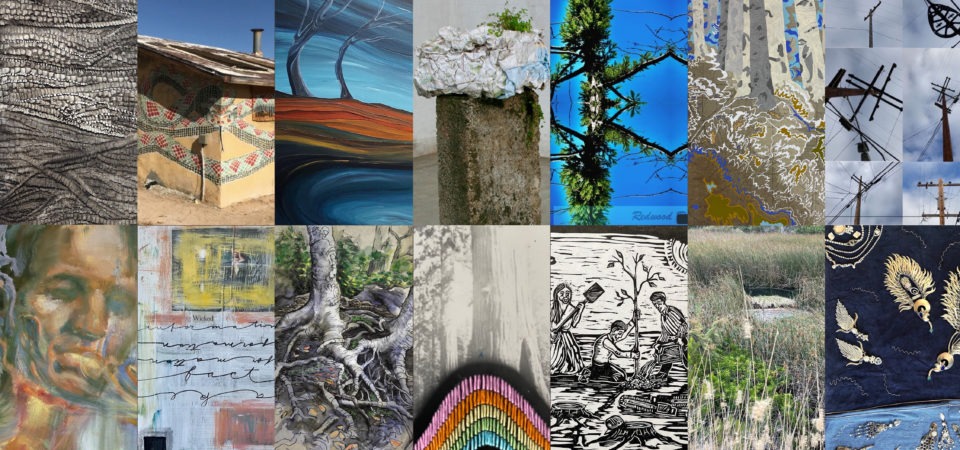Featured Artists
KIRSTEN AABOE (US), SUSAN BERCU (US), MARIANNE BICKETT (US), MARIE CAMERON (US), JOHN CLOAKE (UK), ANA CONSTANTINESCU (UK), CHRISTINA CONKLIN (US), NICOLE COOPER (US), YVONNE C. ESPINOZA (US), SAYAKA GANZ (US), MICHELE GUIEU (US), COLTON HASH (CANADA), SUSAN HOFFMAN FISHMAN (US), TERRI HUGHES-OELRICH (US), JACQUI JONES (UK), DEBORAH KENNEDY (US), ROSALIND LOWRY (IRELAND), SUZETTE MARIE MARTIN(US), QUIN DE LA MER (US), MONA NAESS (NORWAY), MEREDITH NEMIROV (US), CRISTIAN PIETRAPIANA (US), ANNA STUMP (US), PATTI TRIMBLE (US), MARCELA VILLASENOR (US), KAREN VIOLA (US), EILEEN WOLD (US).
This is the 12th What’s Next for Earth online exhibition based on Think Resilience, a free online course by the Post Carbon Institute.
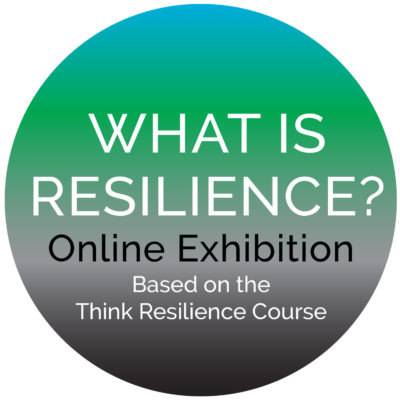 What’s Next for Earth follows Think Resilience, the Post Carbon Institute’s free online course written by Richard Heinberg, one lesson per art call. To respond to this art call, we asked the artists to signup and watch the course, one lesson at a time. The transcript of the lesson “What is Resilience?” is here.
What’s Next for Earth follows Think Resilience, the Post Carbon Institute’s free online course written by Richard Heinberg, one lesson per art call. To respond to this art call, we asked the artists to signup and watch the course, one lesson at a time. The transcript of the lesson “What is Resilience?” is here.
“In ecology, resilience is seen as the ability of a system to absorb disturbance and still retain its basic function and structure. In other words, a system that’s resilient can adapt to change without losing the qualities that define what it is and what it does—which together comprise that system’s “identity.” Resilience boils down to an ability to adapt to both short-term disruption and long-term change while retaining the system’s essential identity. Building resilience starts with decisions about what we value about a system. Concepts like the adaptive cycle and panarchy further aid our understanding of resilience in systems.”
– Richard Heinberg
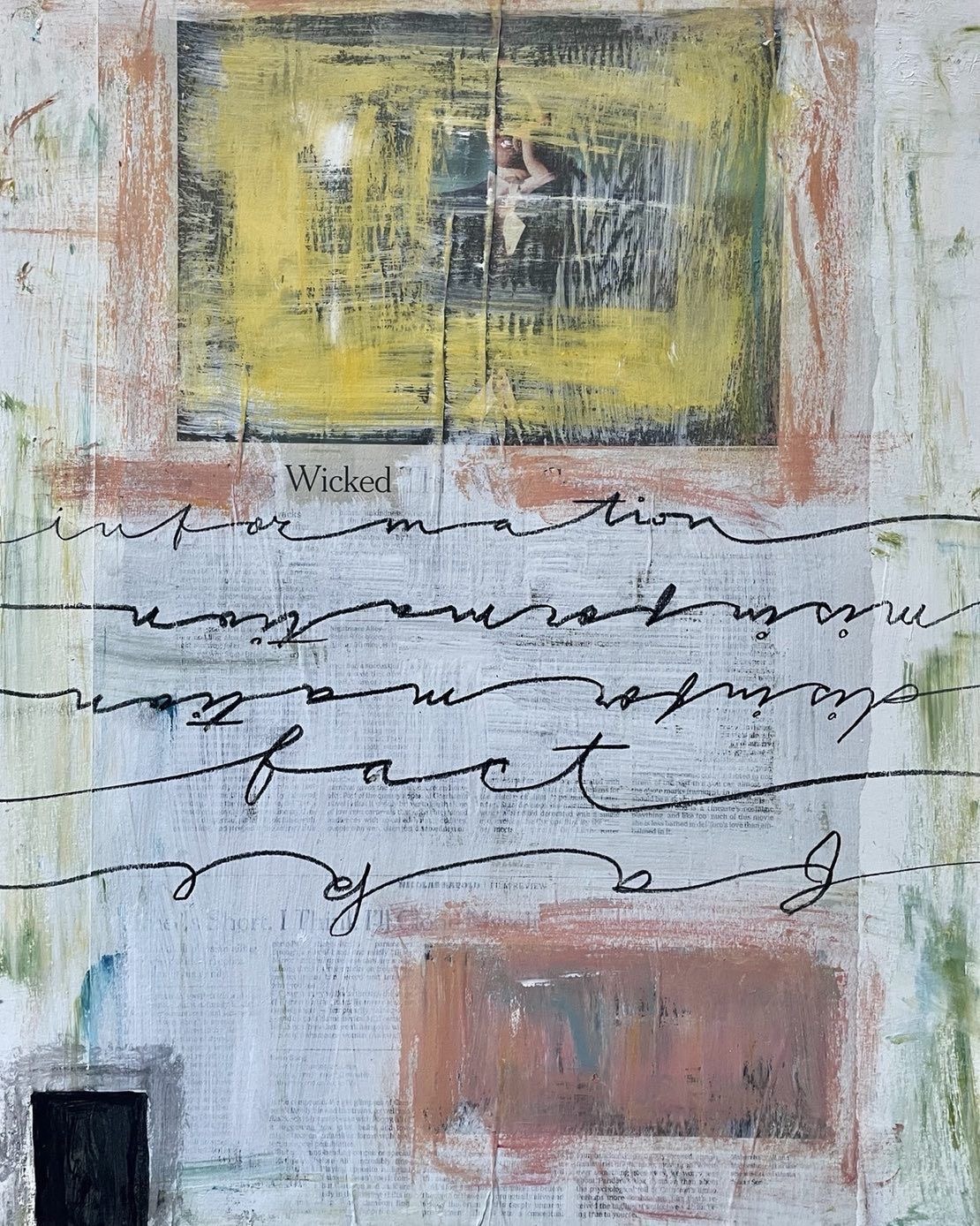
Cristian Pietrapiana
WICKED
mixed media on board 20×16’
2022
“In ecology, resilience is seen as the ability of a system to absorb disturbance and still retain its basic function and structure.” R.Heinberg.
Does our current society have the same ability to face disturbances like misinformation, disinformation, and fake news?
© 2022 Cristian Pietrapiana
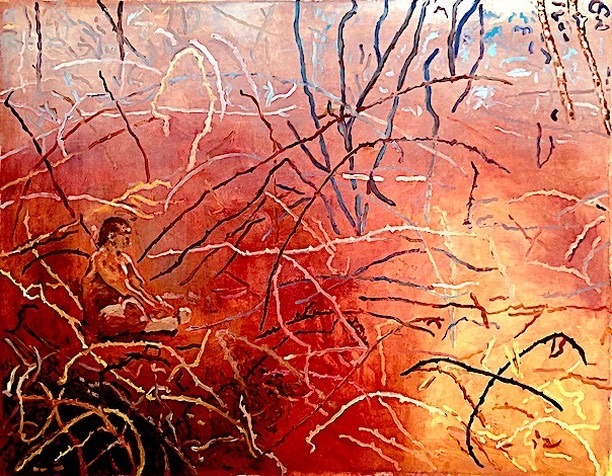
Patti Trimble
MAN IN BRIARS
oil on linen 37″x48″
2022
As an animal, in relationship to plants and other animals during/after a natural disturbance, I rearrange myself. I observe the resilience of the ecosystem, one that also includes my mind and my imagination. Can I avoid heirrarchy, observe and think from within? I think it is true that regarding Resilience, “the qualitiy of presence defines what it is and what we do.”
© 2022 Patti Trimble
Ana Constantinescu
UNBEARING LANDS
Part I and II
Acrylic on canvas
594 mm x 420 mm x 20 mm each
In response to the @whatsnextforearth art call, the two parts artworks depict a dystopian landscape and portray the resilience of nature that emerges back to life, even after the damaging effects of climate change and humankind mistakes. As does nature, we also have the ability to adapt to difficult situations and find creative solutions to the unpredictable changes of our over-changing environment
© 2022 Ana Constantinescu
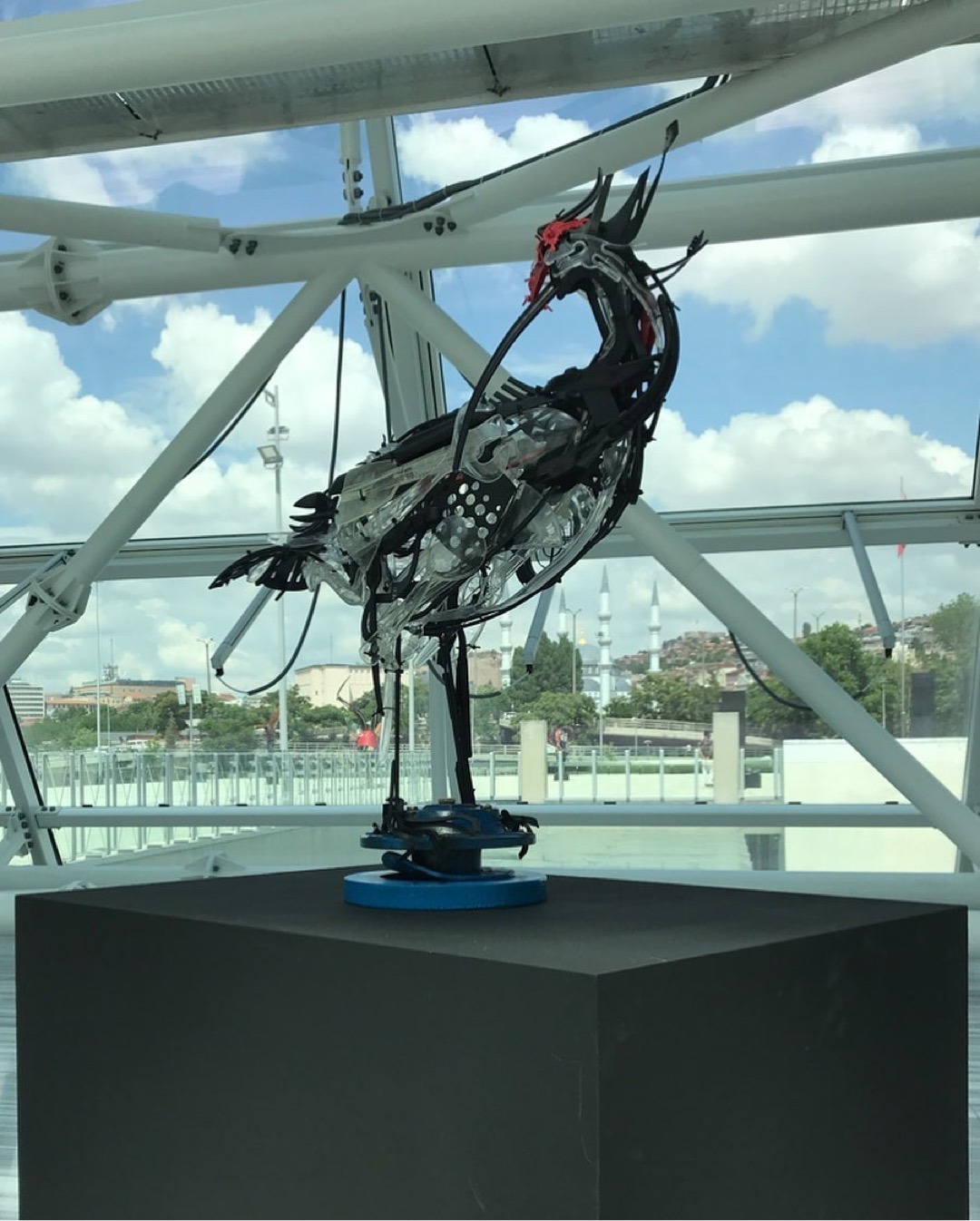
Sayaka Ganz
NORTHERN BALD IBIS
Reclaimed plastic
What is resilience? In my reclaimed plastic works, I believe what makes them strong is the flexibility of the network of cable ties and electrical wires that connect the plastic objects. In the case of the Kelaynak, or the Northern Bald Ibis, the people of Turkiye have been able to mend or supplement the access to resources that these birds needed to survive, and their population recovered.
© 2022 Sayaka Ganz
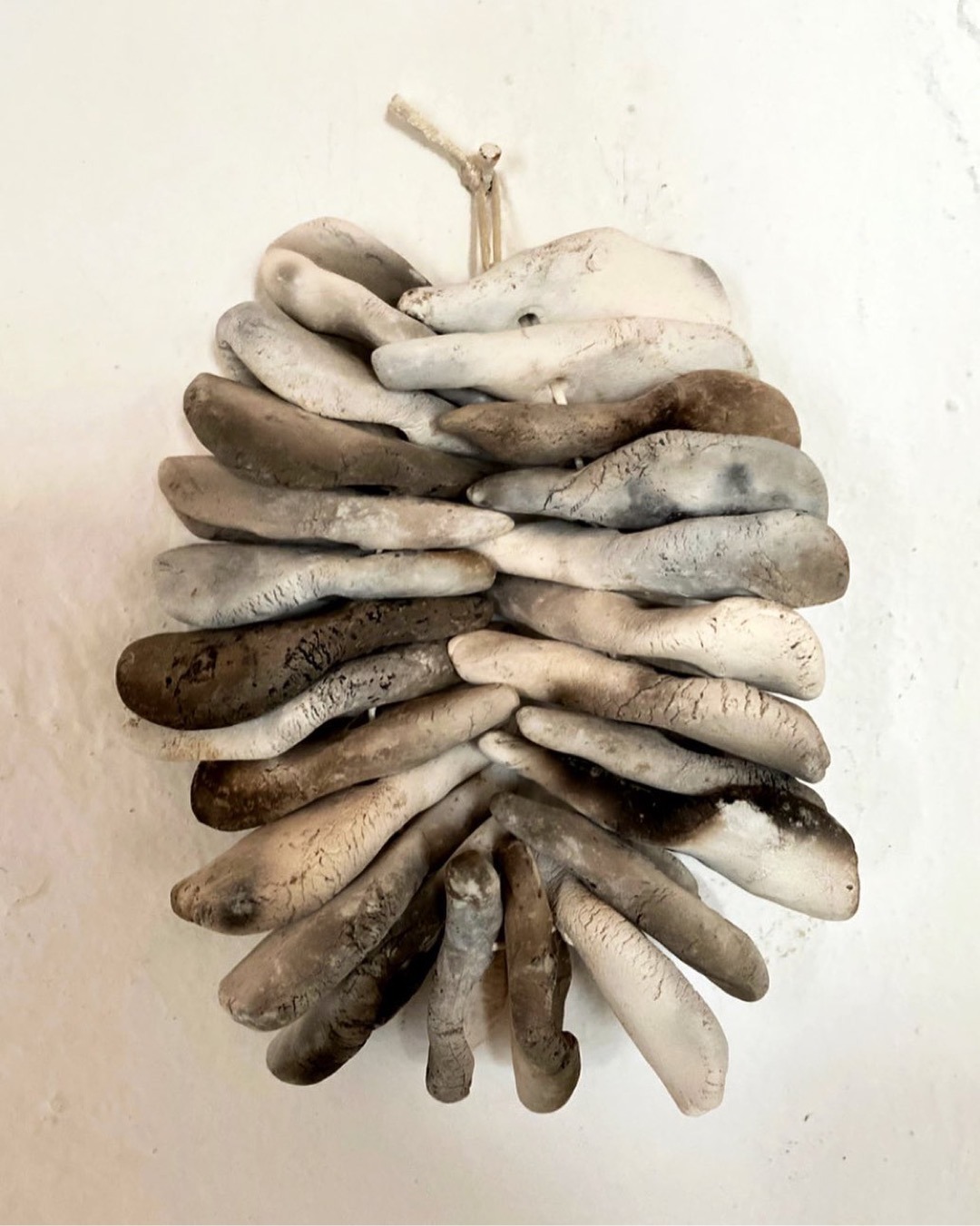
Mona Naess
I FOLD MY HANDS
Smokefired porcelain sculpture 2022
16 x 20 cm
The very fragile material, porcelain, becomes in my mind a metaphor for life. Even after being exposed to extreme conditions in the flames and hot ashes, the material shows resilience and willingness to recover after it has gradually cooled down. But the chance of explosion is constant! The sculpture is a gentle reminder of how we need to change.
© 2022 Mona Naess
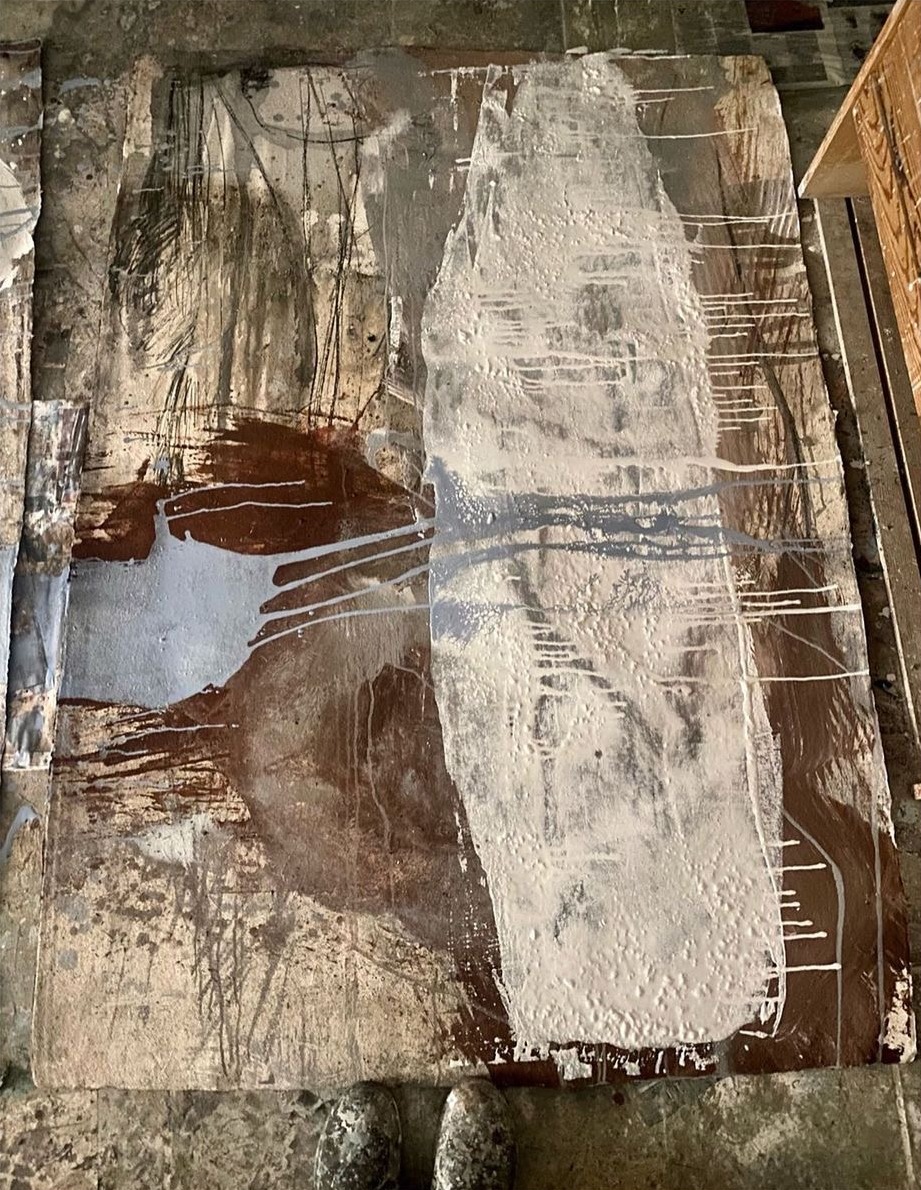
Mona Naess
EARTH MAP. MAPS AND TERRAIN NO LONGER MATCH. OUR EARTH IS OUR CANVAS, IN WHICH WE HAVE TO ACT.
Ashes, earth, water, ink, etc on Rag Paper 400 g.
110 x 160 cm
I struggled and almost «slipped into it,» and it felt like a scary metaphor for the dramatically increasing climate change and instability that gnaws in my subconscious. Everything is interconnected; decide what you will focus on and build resilience.
© Mona Naess 2022
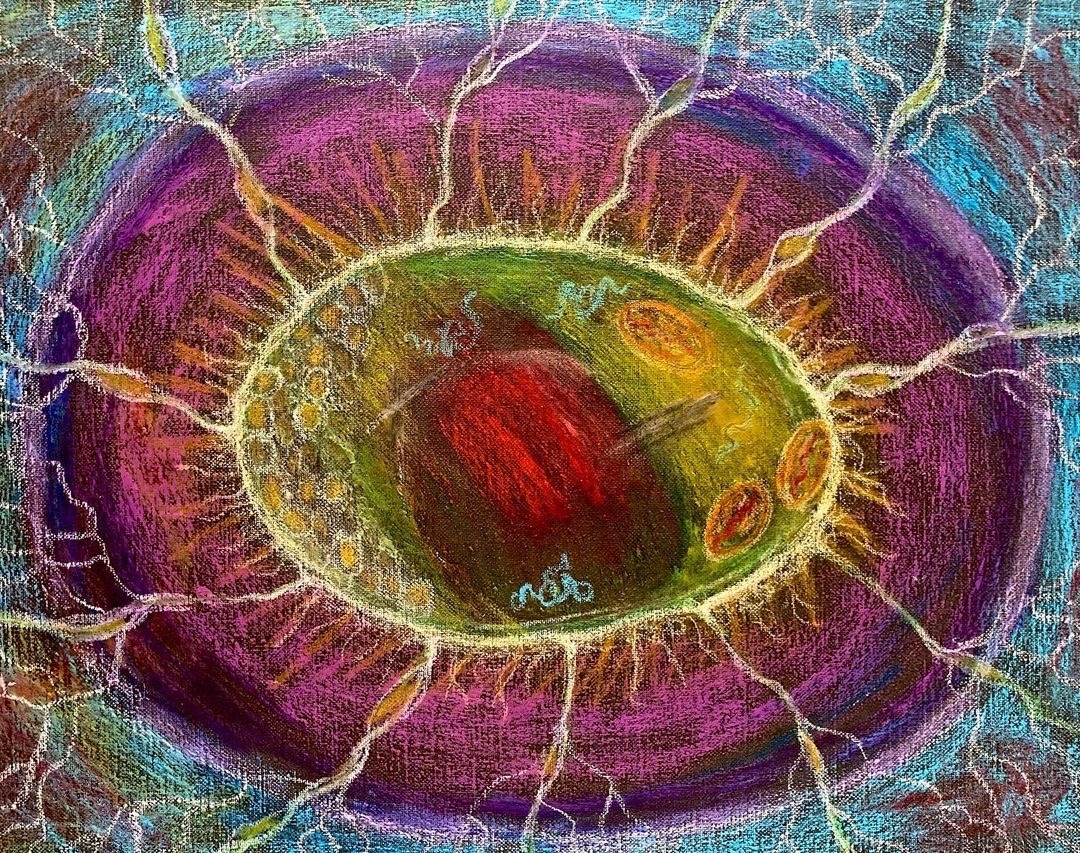
Marianne Bickett
SMALL SCALE SYSTEMS: CELLULAR PANARCHY
Oil pastels on canvas
15”x20″
This Art Call refers to Richard Heinberg’s Think Resilience online course regarding the issues around climate change, history, present conditions, and possible futures. From Lesson 13 in Part Three: The Basics:
“Resilience is…the ability of a system to absorb disturbances and still retain its basic function and structure.” Resilience “starts with what we value.” Our ability to be open to new ideas, to trust, and to deepen our connections create a system whereby we are able to adapt and thrive.
Resilience embodies two concepts: 1) The adaptive cycle that involves “resource organization, growth, conservation, and release.” 2) Panarchy in which “systems exist at multiple scales of space and time, and interactions across those scales determine what’s happening within the system…”In this image I created for this Art Call, I wanted to depict a component of a very small-scale system, a cell. This is my imaginary cell with some basic attributes of a real cell such as a nucleus, membrane, mitochondria, etc. Millions of years ago, cells began to form communities and specialize because it was to their survival advantage to do so. This enabled them to be much more efficient and resilient. Cells are incredibly adaptable and responsive to our thoughts. As Richard mentioned, resilience starts with what we value. I feel that in order for our society to change, people need to value their individual and community health and well-being. Our cells are listening to our thoughts and we can, at a very basic level, build resilience and change. Thank you!
© Marianne Bickett 2022
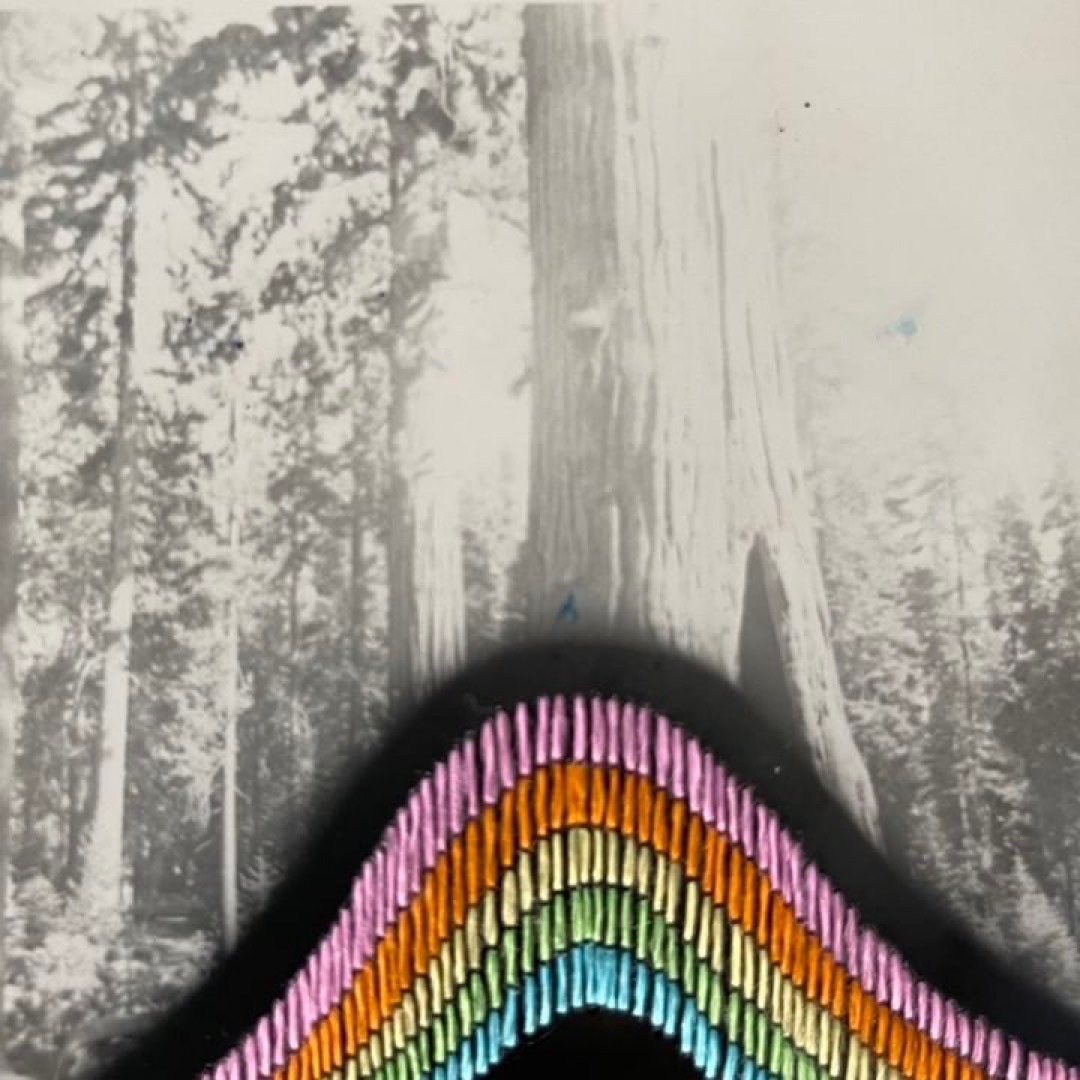
Marie Cameron
GENERAL SHERMAN TREE BURNBOW
Silk thread on vintage photograph
3 1/2″ x 3 1/2″
2021
While reflecting on “What is Resilience?”, What’s Next for Earth’s new call, I can’t help but think of our forests, especially our groves of Giant Sequoias that have withstood centuries but now struggle with climate change and the increasingly persistent and dangerous droughts and forest fires. These giants are the lungs of our planet and part of a complex, intelligent ecosystem that has evolved over millennia. We are actively disrupting that system.
We must now stand strong, intelligent, and resilient like a forest of Sequoia, doing all we can to battle climate change because are all in this together, and no matter how strong and resilient we may be, we all have out breaking points!
© Marie Cameron 2022
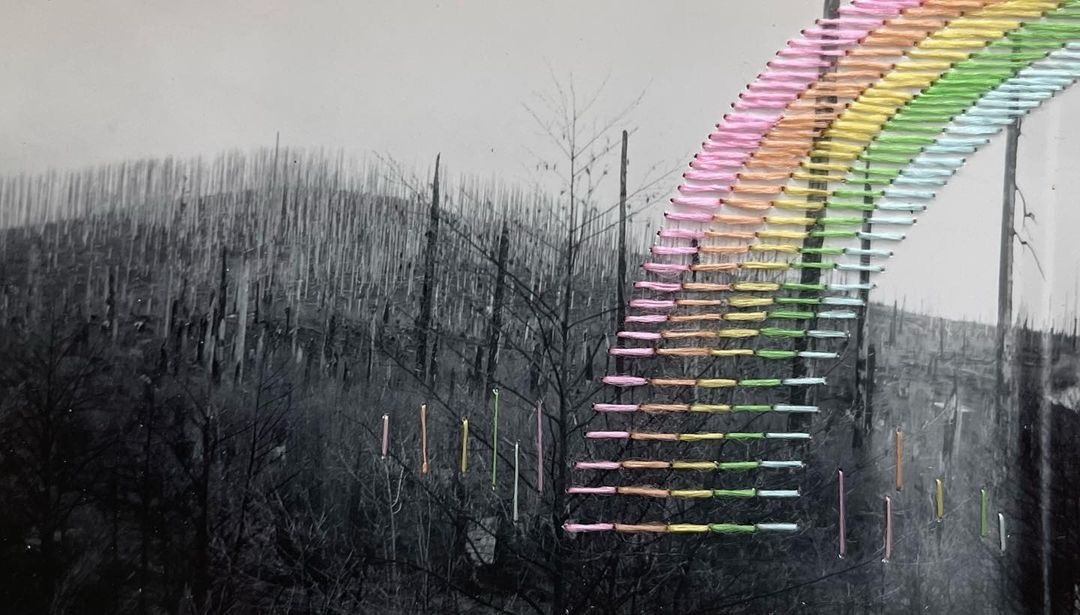
Marie Cameron
RAINBOW ON THE BURNSCAR
Silk thread on vintage photograph
3 1/2″ x 3 1/4”
2021
When I think of Resilience, I think of a forest coming back to life after a fire, but oh, at what cost!
The pace and intensity of these fires now speak to a bleak, hot and dangerous future if we do not take global, systemic steps to avoid what must not become the inevitable.
© Marie Cameron 2022
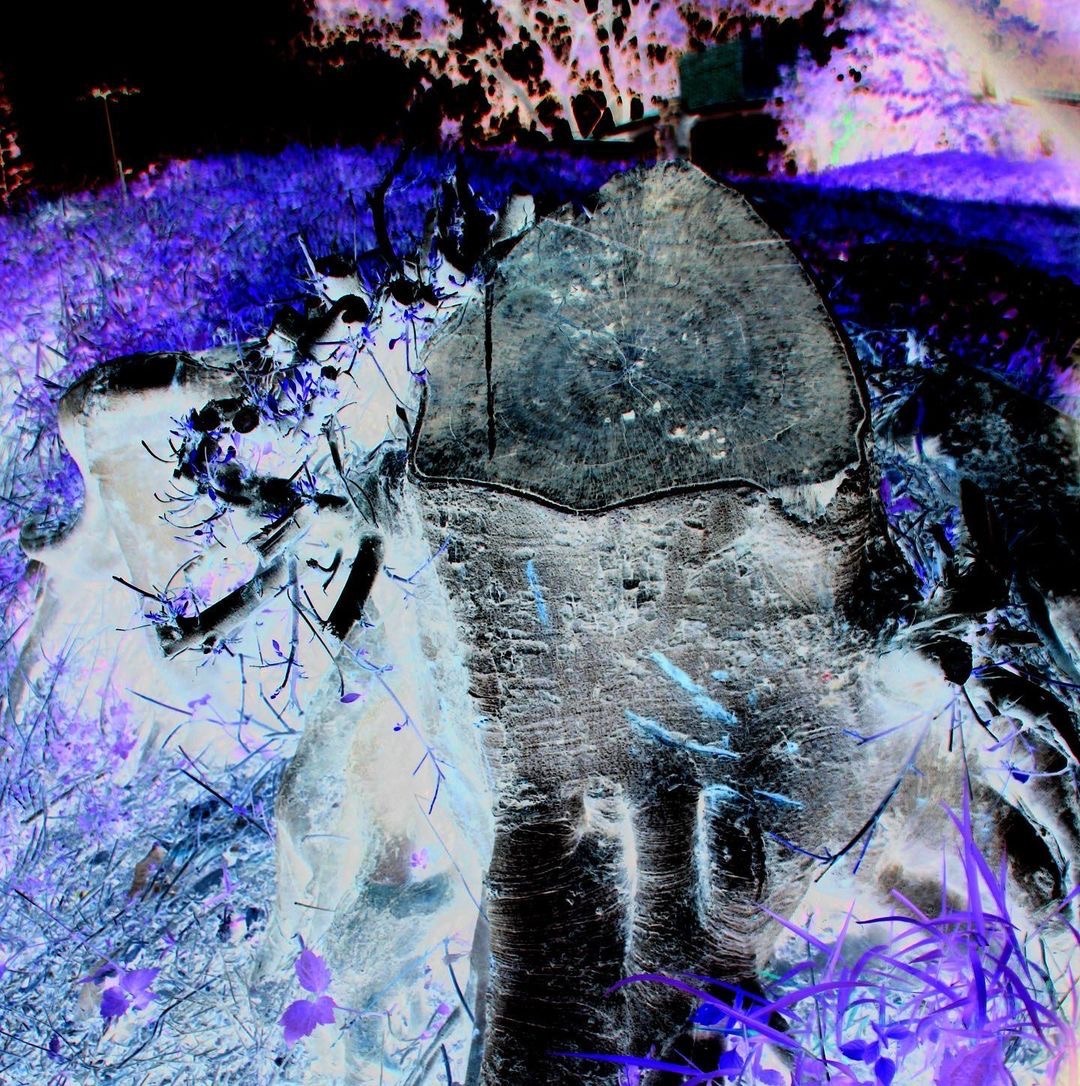
Marcela Villaseñor
SPROUTS / RETOÑOS
digital photograph, fotografía digital
2022
This tree was cut seven years ago, but every year during the rainy season, his executioner prunes it down. The trees’ resilience is no match for their human executioners. “Resilience is often thought of as the ability to withstand hard times or shocks, and to “bounce back” from a disaster” Richard Heinberg
Este árbol fue cortado hace siete años, pero cada año durante la temporada de lluvias su verdugo lo poda. La resistencia de los àrboles no es rival para sus verdugos humanos. “La resiliencia a menudo se considera como la capacidad de resistir a tiempos difíciles o conmociones y de “recuperase” de un desastre”
© Marcela Villaseñor 2022
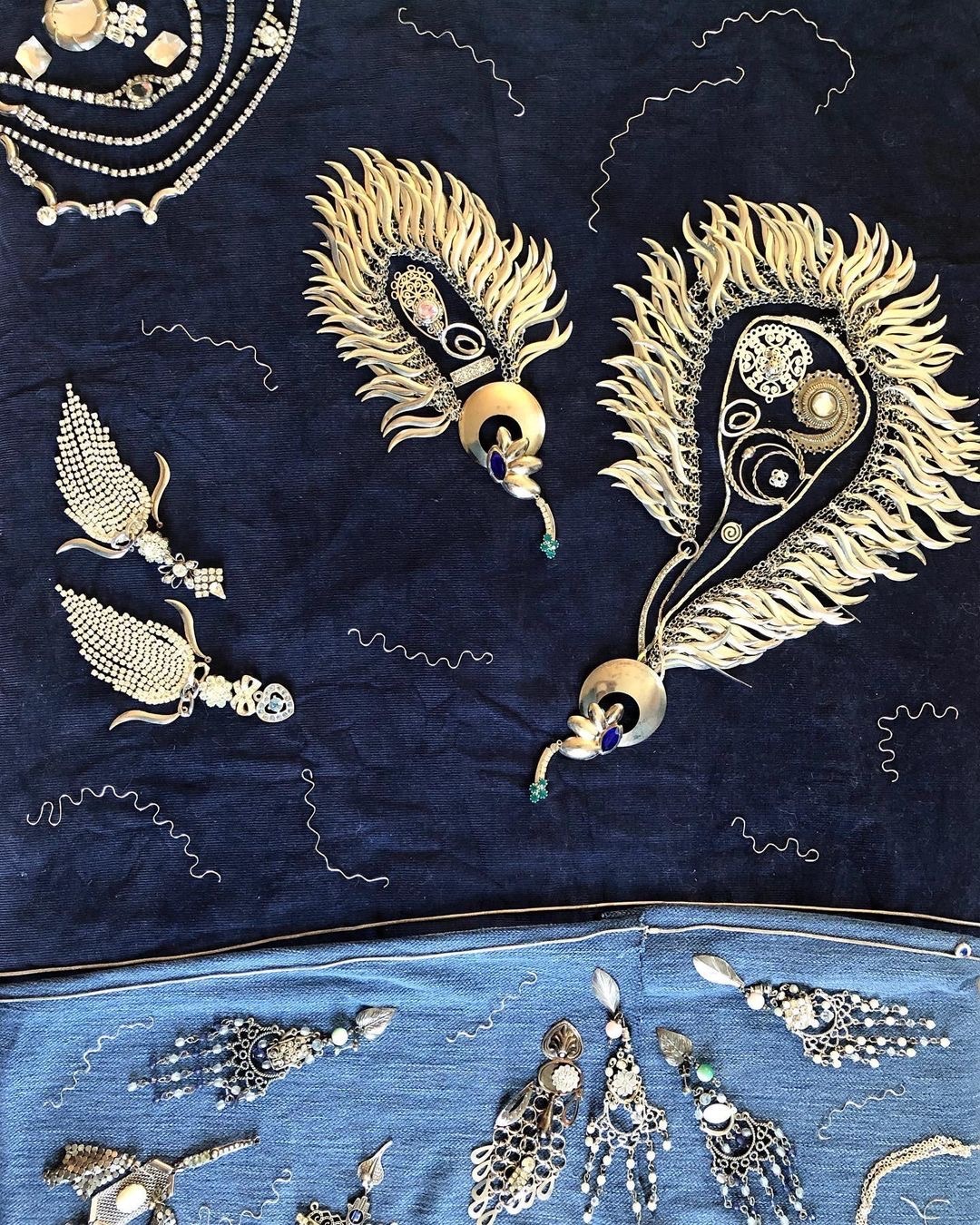
Yvonne C. Espinoza
ARTIFICE, ARTIFACT, AND ACTUALIZATION
Part of the Material Evolutions series.
(Work in progress)
Repurposed textile, jewelry, wire, on stretched canvas.
22″H x 18″W
In ecology, resilience is seen as the ability of a system to absorb disturbance and retain its basic function and structure. In other words, a resilient system can adapt to change without losing the qualities that define what it is and what it does—which together comprise that system’s “identity.” Resilience boils down to an ability to adapt to both short-term disruption and long-term change while retaining the system’s essential identity. Building resilience starts with decisions about what we value about a system. Concepts like the adaptive cycle and panarchy further aid our understanding of resilience in systems.” – Richard HeinbergMy work takes a systems thinking approach to defining boundaries and imagines a snapshot of complex adaptive cycles working within a panarchy of “biological” beings made up of human-conceived “DNA” material.In this work I am studying the identity of communities, the ecotone, and levels of activity within each community. The ongoing evolution of each community is unknown, but dependent on how each community has dealt with diversity and redundancy.
© Yvonne C. Espinoza 2022
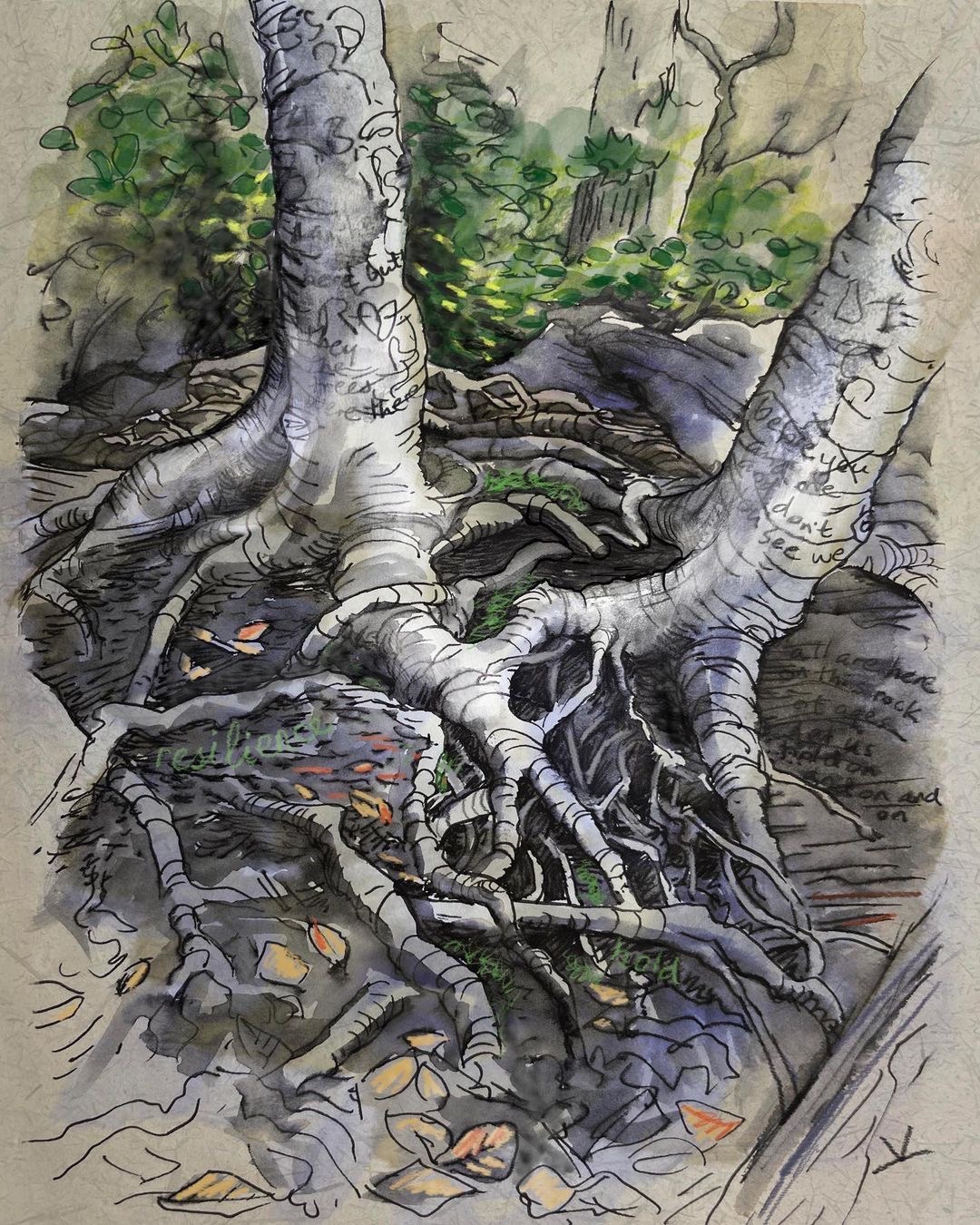
Karen Viola
BEECH COMPANIONS
Ink on paper, 6 x 8 inches.
Done mostly on location at Cranberry Lake Preserve in Weschester county, NY with a bit of digital painting at home.
2022
I have sketched these particular trees before at various angles and each time I notice something new. Today’s surprise was noticing how they were actually fused together through their roots.
This fusing together is just one of the many amazing things these and many other trees can do. The stronger individual provides nutrients for the weaker because they know as trees know that their fates are tied. They join together as one in the struggle for survival. I wonder if the people who carved their marks and professed their love on the bark of these trees noticed this beautiful romance of resilience at their feet.
Can humans learn about resilience from trees? I know I do. I have also learned much from the Think Resilience course sponsored by the Post Carbon Institute (tags below) and I urge everyone reading this to please check it out, it is a valuable (and free) resource.
© Karen Viola 2022

Kirsten Aaboe
A RESERVOIR IN SOUTHERN CALIFORNIA
Photograph
2022
Resilience is possible if the supporting and interrelated systems are strong enough to allow adaptation to heal from the damage, shock, or disruption.
© Kirsten Aaboe 2022
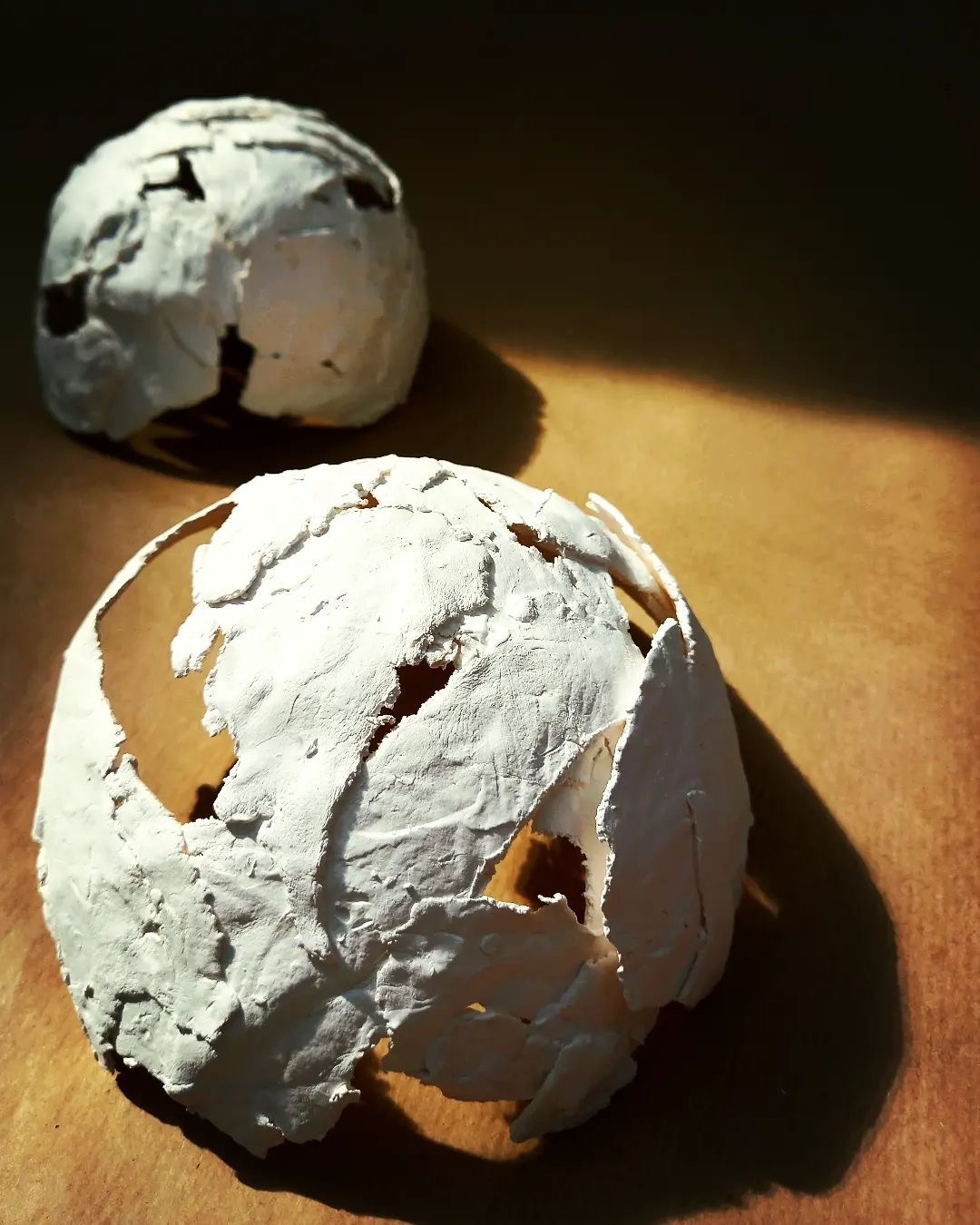
Rosalind Lowry
TWO BANDAGED PLANETS
Porcelain clay. Ultra fragile!
2022
20cm diameter
Two bandaged planets, still functioning and trying to adapt to long-term changes.
© Rosalind Lowry 2022
Suzette Marie Martin
DRY RIVER
watercolor and graphite on paper
2022
View Gallery
The absolute luxury of abundant, clean, hot and cold water from a tap is something that we rarely acknowledge in industrialized cultures.
The scarcity of water is already a reality across many regions of the world. Prolonged droughts are predicted to escalate across the globe in the coming decades, along with the loss of deepwater aquifers drained through industrialized agriculture and irrigation practices, salinization of freshwater from sea level rise, and water polluted through sewage, industrial toxins or agricultural run-off.
As more regions across the globe face severe water shortages, resilience means adapting to water restrictions appropriate to our changing climate.
In industrialized societies, limiting the frivolous, recreational uses of water for things like golf courses or lawns in the desert, or wasteful industrial uses (like fast fashion production) need to become socially unacceptable and regulated for wasteful water usage.
Adopting personal water saving habits now are essential cultural changes to support water shortage resilience within our local communities.
© Suzette Marie Martin 2022
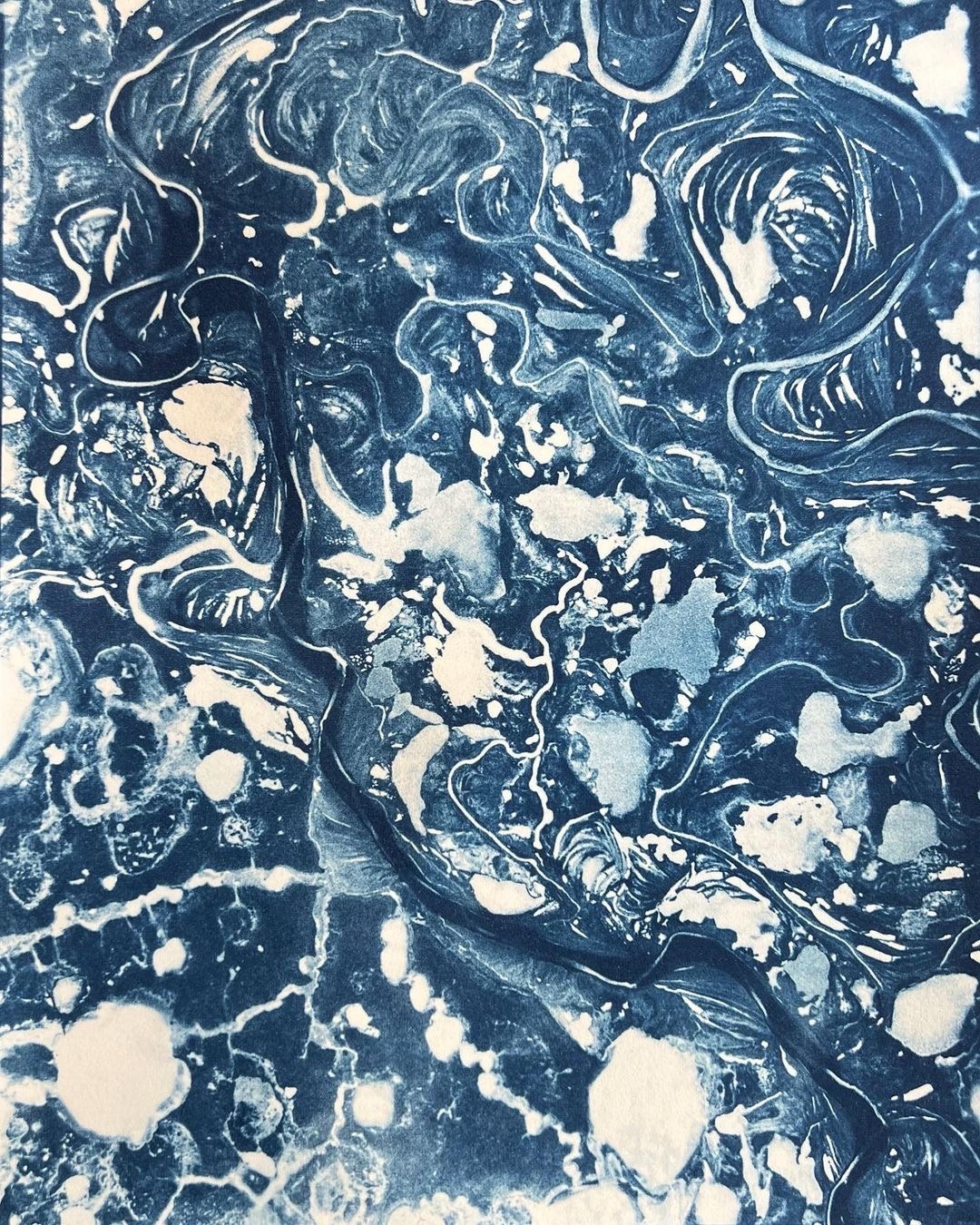
Susan Hoffman Fishman
SIBERIAN SINKHOLE VIA SATELLITE #8
Image of Siberian sinkhole and changing Siberian ecosystem
Cyanotype on paper
10” x 12″
2022.
Permafrost in areas of Siberia is melting rapidly as a result of warming temperatures and causing methane to be released from underground reserves. The released methane gases explode and leave behind gaping sinkholes. In addition to showing dozens of sinkholes, this image reveals numerous oxbows or remnants of rivers meandering across the landscape over time. Russian settlements in the Arctic are classified as at particularly high risk for damages to infrastructure and livelihood from The loss of permafrost requiring significant resiliency planning to maintain strong communities.
© Susan Hoffman Fishman 2022
Jacqui Jones
VALUING THE WILD
Sculpture – Size: H60cm xW20cm x D20cm
Materials: concrete blocks, ordnance survey maps of Norfolk UK, native plant
2022
Made with maps of Norfolk in the UK, highlighting areas of rewilding that are currently being developed. The work is a celebration of environmental resilience shaping a landscape in recovery.
© Jacqui Jones 202
Nicole Cooper
WOVEN IN TIME (TRIPTYCH)
Oil on Canvas
60 x 120 inches
Though “Woven in Time” has many meanings to me, I believe it expresses resilience in the human spirit and an underlying warning about our impact.
Humans are connected biologically and spiritually through generations. My 10-foot wide painting invites the viewer to stand alongside a wave of life-sized, interconnected figures—each woven together by brushstrokes—rolling forward in time. While painting, I was thinking about the passage of DNA. Every human today is genetically woven into our time and place after all those who came before us… all the way back even to prehistoric humans.
Imagine the hardships humanity has faced through millennia. Ice ages, disease, disasters. Yet we persist as humans to the core, much of our success coming from our big brains and adaptable nature. There are times when our ancestors have lived in harmony with nature and, more recently, at the expense of it.
As the wave in my painting suggests, humanity can also be a growing, unstoppable force moving into darkness. We must be mindful of our impact—an impact made all too clear now that WE’VE pushed NATURE’S resilience to the brink.
I believe hope lies in our human adaptability. We are lucky at this moment to have the time (however short), technology, and self-awareness to choose to change course. Creating a vision like “Woven in Time” allows me to see myself as a part of a larger, connected system. To grow my awareness about the wisdom of our ancestors and think about generations to come. How do we build resilience in our communities with a generational mindset that resonates with our natural world?
© Nicole Cooper 2022
John Cloake
THE FINAL FOREST
REGENERATION
linocuts, 30x20cm on washi paper
2022
While working on my Climate Crisis print series, I have been catching up with The Post Carbon Institute’s online course “Think Resilience.” In nature’s “Adaptive Cycle,” certain adaptive species flourish in the aftermath of a shock. They may rapidly dominate the environment, but without diversity, they exhaust resources and become less resilient until they are themselves vulnerable to shock.
My Climate Crisis series views the push for ever-increasing “Economic growth” in this light. After a long period in which progress and even “freedom” have been equated with unrestrained consumerism and resource exploitation, we face resource scarcity and an existential Climate Crisis. In this context, what does “Resilience” mean? Certainly, it is about adapting. But surely not seeking to preserve the old system intact. That system is already dying. Rather, the crisis offers an opportunity to develop a new resilience based on rethinking our core values and the development of new (and probably some very old) narratives about value and worth.
The prints in this series are often paired. One expressing anger and one projecting a more hopeful future in which the connotations of “Anthropocene” shift from destruction, fear and denial towards symbiosis, respect, and positive engagement with our ecosystem.
© John Cloake 2022
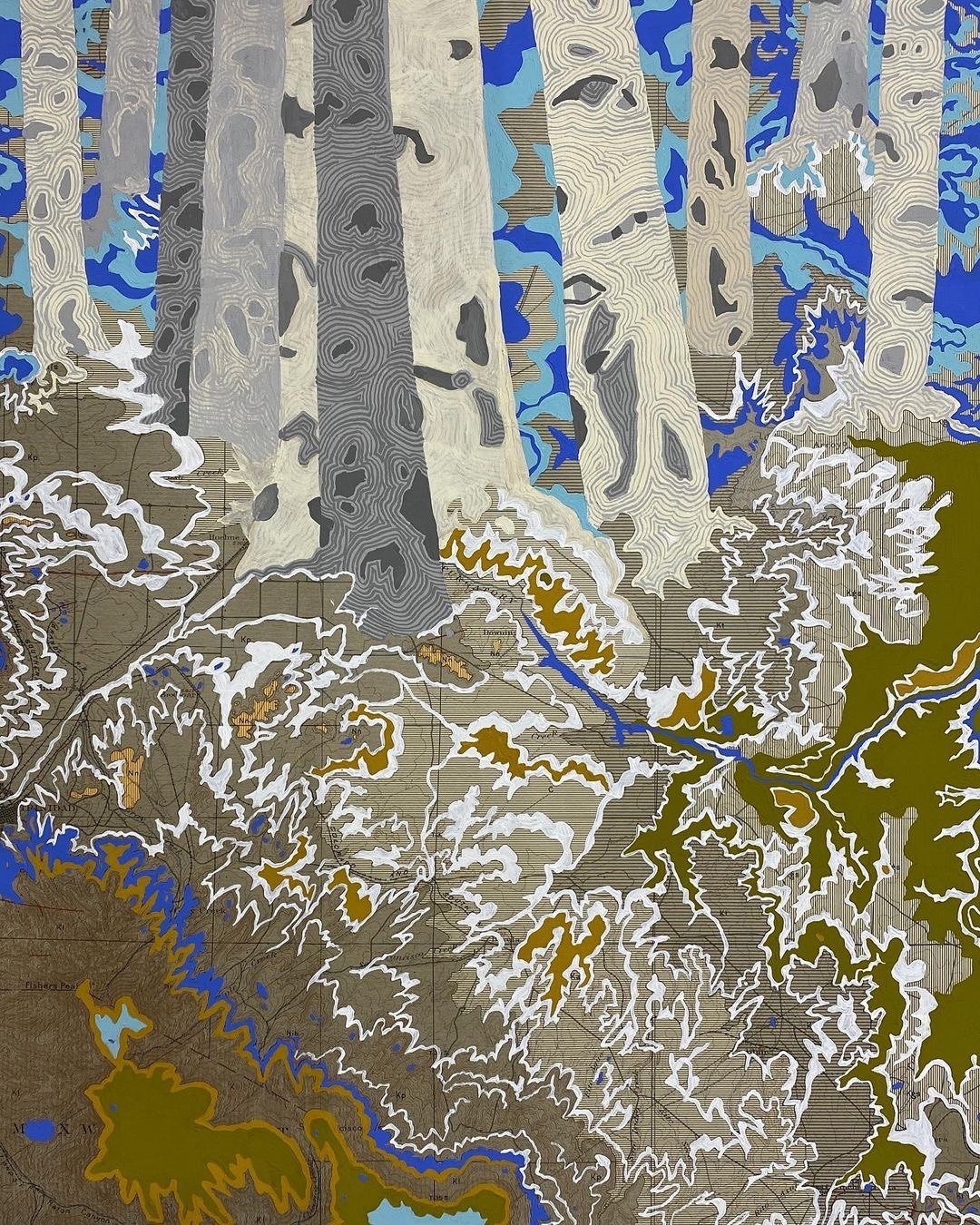
Meredith Nemirov
RIVERS FEED THE TREES #455
Acrylagouache on historic topo map
17″ x 13.5″
2022
If there is resilience in the forest it owes a great deal to the mycorrhizal network of fungi that grows underground. The symbiotic relationship between these thin white strands of fungi which spread for miles below the forest floor, and the trees growing above contribute to the ongoing cycle of mutual adaptation. Some fungi help the trees and plants to adapt to and survive drought conditions and fight off invading pests. It is a web of organisms dealing with crises together. It is wise to remember that we cannot be resilient on our own.
© Meredith Nemirov 2022
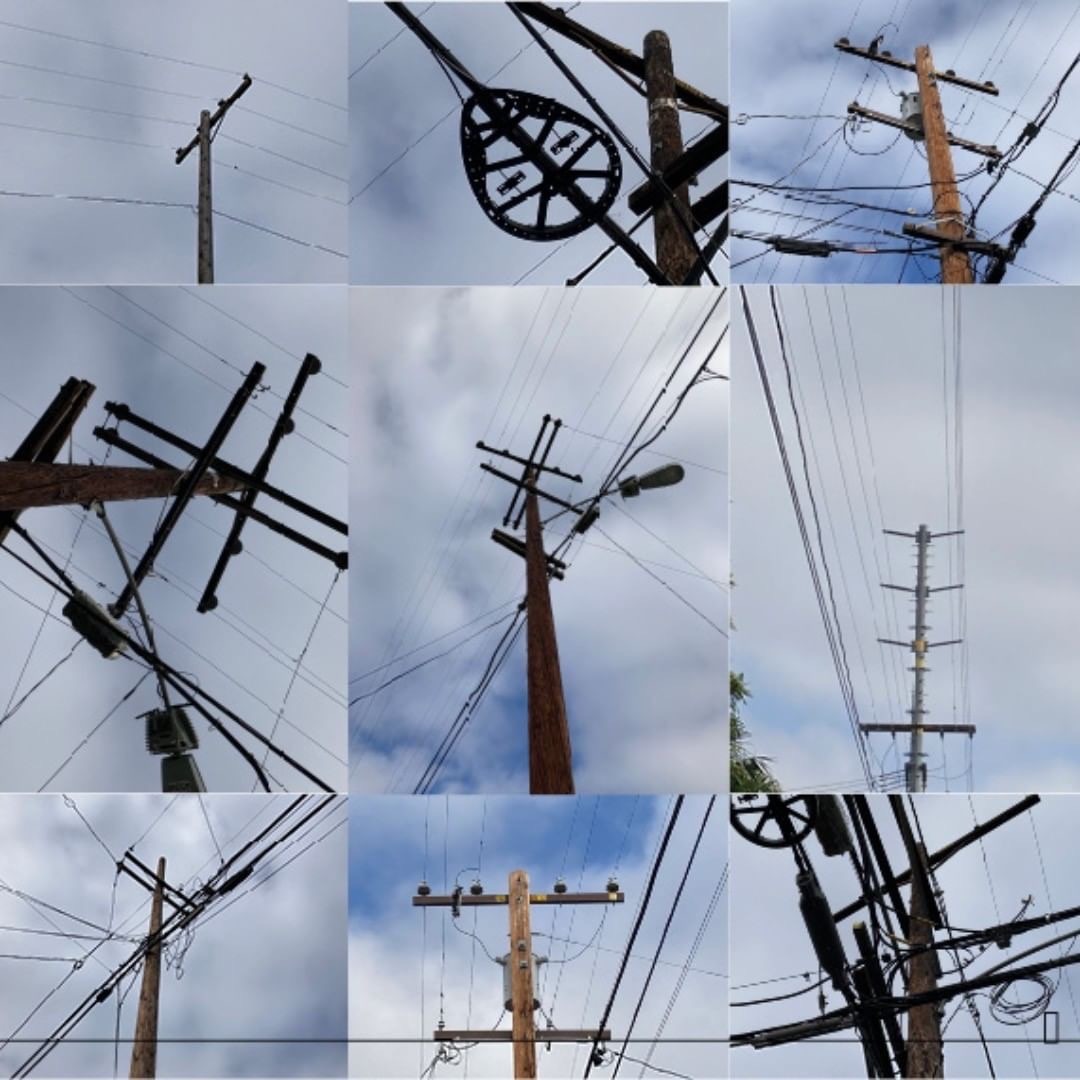
Terri Hughes-Oelrich
JUST TRANSITION
digital art
2022
As our society transitions from oil to green energy, how will the power grid change? Will these beautiful wooden poles in my neighborhood be gone underground, will they get bigger, or will they be replaced by steel? While increasing green energy, how can we justly transition with the oil industry being transformed into power storage or other beneficial energy production? It’s exciting to think about how we can be resilient.
© Terri Hughes-Oelrich 2022
Colton Hash
EVOLUTIONARY FOREST
Real-time simulation of an ecosystem that adapts to wildfires and disease epidemics amidst climate change.
2022
In a temperate climate, disturbance events maintain a patchwork diversity in the forest ecosystem, but with warmer temperatures, wildfires and disease outbreaks become more devastating. If a tree species becomes extinct, it is replaced with a new species that may be more suited for the hotter climate, allowing an impoverished ecosystem to adapt to catastrophic change.
Each time this simulation runs, a new landscape is generated with a unique mix of tree species each possessing different behaviour. Evolutionary Forest is coded with interrelated cellular automata processes to approximate vegitative growth, soil, water, disease and wildfire. As an artform, this generative simulation allows viewers to explore potential futures amidst climate change, and to consider principles of ecosystem resilience.
After witnessing dramatic changes in forest ecosystems that are part of my home, I am driven to create digital artworks that reflect the nuance and complexity of climate change.
Evolutionary Forest continually surprises me, often creating dramatic narratives of trees struggling to adapt to climate change. The landscape in this video starts with a balanced disturbance regime, then as the lake dries up, larger fires wipe out most of the vegetation and create a desertified landscape. However, one of the original tree species survives, and a new species is introduced that thrives in the hotter and drier climate. A resilient forest ultimately survives, although with less biodiversity and impoverished aesthetics.
© Colton Hash 2022
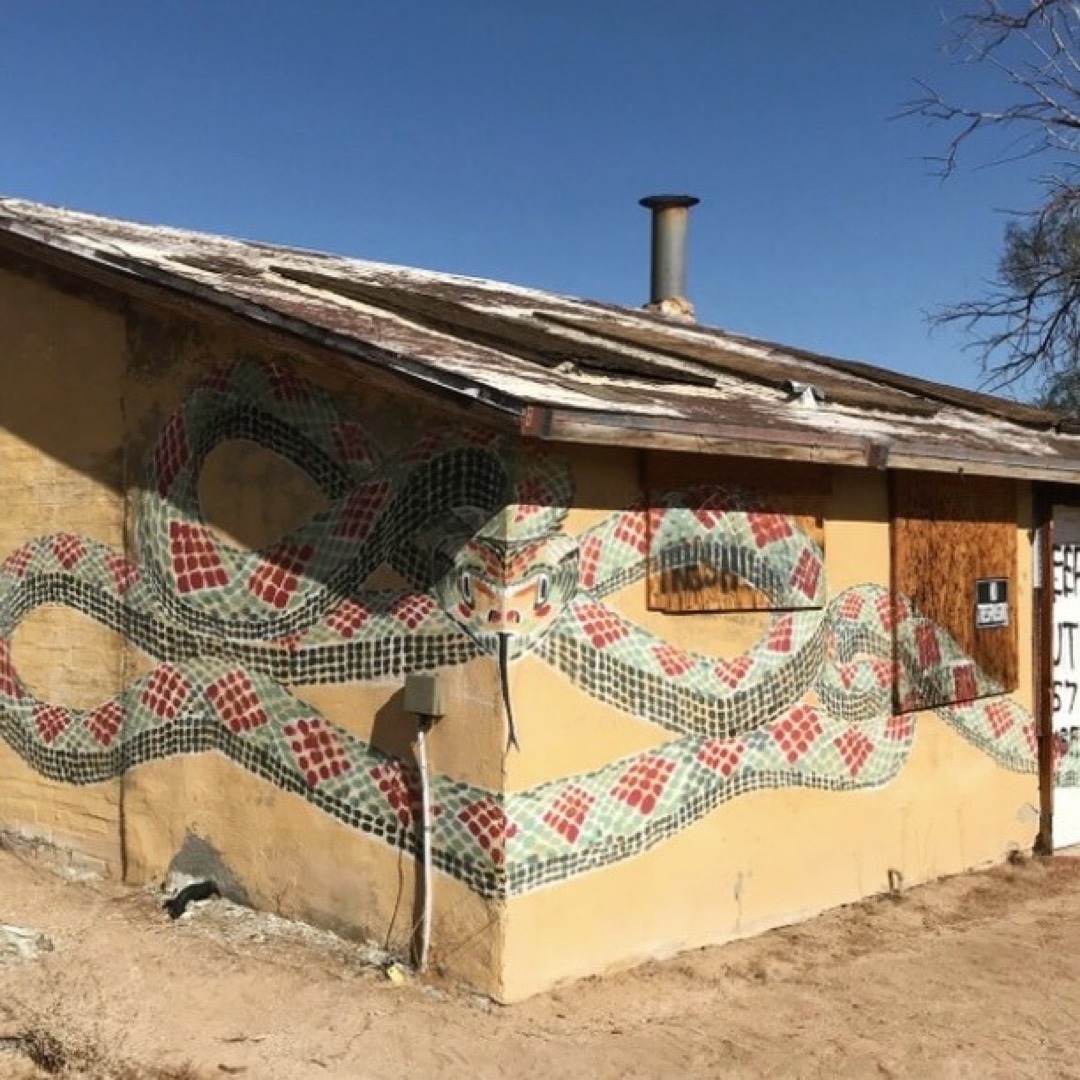
Anna Stump
MOJAVELAND
A place to play and experiment with art.
pictured: snake mural on homestead
What is resilience? Resilience is adapting to change, while retaining its basic function and structure. How is Mojaveland a resilience project? Mojaveland is an interactive art center in the High Desert of California that uses sports to reach multigenerational families. The property that Mojaveland inhabits was abandoned for 30 years, but once thrived as a homestead, with trees and trout ponds in the middle of the Mojave. I am trying to honor the original owner, who had a sense of adventure and mischief, while offering the community a place to play and experiment with art. Currently, Mojaveland’s artist-designed miniature golf course has 13 holes, with other art installations dotting the property. Eventually I hope to bring water and solar power to the plot, and restore the old homestead. Part of Mojaveland’s mission is to reuse and restore as much as possible, encouraging growth of the desert flora and fauna.
visit mojaveland.com.
© Anna Stump 2022
Quin de la Mer
TEXTURE OF TIME (CARBON)
Abstract oil painting
sustainable materials, found foraged carbon from Holy Island lindisfarne used as pigment
15×5 feet
2022.
The current art call, What Is Resilience, brings to light the concept Panarchy. As Richard Heinberg from Post Carbon Institute notes, “Panarchy is the idea that systems exist at multiple scales of space and time, and the interactions across those scales help determine what’s happening within the system you’re studying.” He goes on to explain, because systems don’t exist in a vacuum, they are part of a larger-scale system and made up of smaller-scale systems. While current events affect all systems involved, events that happened in the past as well as plans for the future also affect the whole system in the present.
I am particularly drawn to Panarchy, feeling the pull to see our current predicament at a very large scale, a universal scale.
I created this painting, Texture of Time (Carbon), as part of a series about Existence Tissue experiencing The Last Exhale. Time itself being the system capable of remarkable change as it holds the past that is underneath and within, the present that is perceived, and the future that is beyond the horizon. I acknowledge change and persistence as essential factors in the fabric of resilience and see Time as a guide providing alignment with the universe.
© Quin de la Mer 2022
Christina Conklin
COLLAPSE COLLAGE: WHAT IS RESILIENCE?
collage I and II
2022
In this Collapse Collage, resilience lies somewhere in the sacred geometry of a butterfly’s egg as it meets a floodable Mexican town, where the streets become canals in the rainy season. The ivory figure hails from the Dorset people, a pre-Inuit people of the Arctic who knew how to live within the rhythm of their world; she’s at the center (covering the church at the heart of the village), because we made the mess and need to make the new/old way forward. Watchful Old Turtle is also present, hoping we don’t fuck it all up.
© Christina Conklin 2022
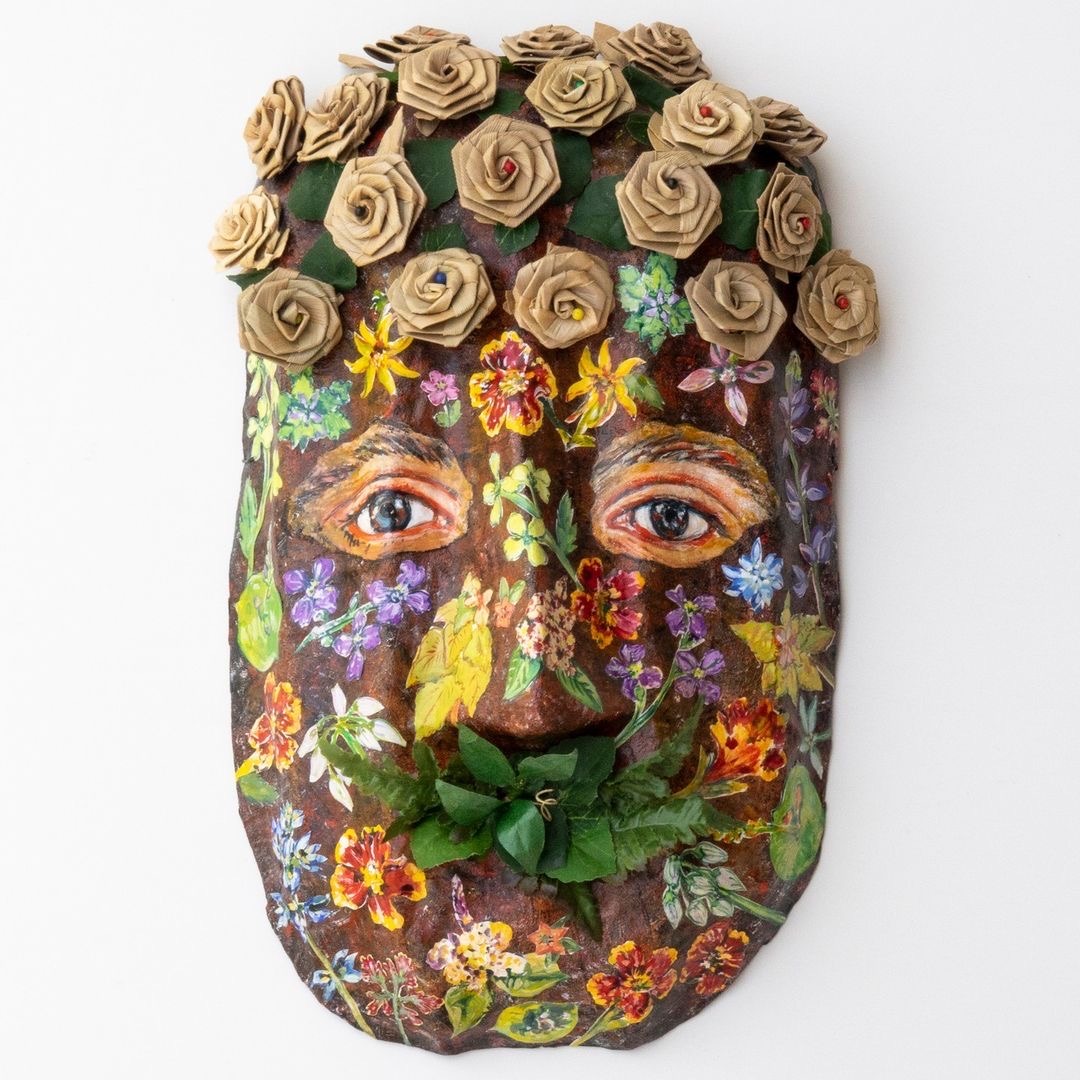
Susan Bercu
FIRE FLOWERS
Assemblage mask: paintings, recycled newspaper, found rattan flowers and plastic leaves, stick pins.
10 in. wide x 13 in. high x 5 in. deep.
Fire Flowers is my wall mask created during the extreme drought in the aftermath of the “Glass” wildfire that roared down the parched creek 30 feet from our Sonoma County, CA home in 2020. Teams of firefighters saved our house and those of neighbors from this 67,000-acre wildfire. Its destruction is still apparent today in swaths of charred tree skeletons on our surrounding mountains. The following spring of 2021, a surprising variety of tiny wildflowers stubbornly poked their heads through the ash and rocks in the dry creek bed. I celebrated them in acrylic paint then decoupaged them on my brown ridged papier-mâché face, entitling the completed mask “Fire Flowers.”
The Post Carbon Institute’s chapter, “Think Resilience” is a roadmap for us humans to flourish in harmony with nature. In California, fires are dramatically increasing because of climate change. Our county has a comprehensive environmental plan including fire-wise measures with much education and work to be done. “Fire Flowers” is a testament to Nature’s resilience but demands the concerted allegiance of responsible community.
© Susan Bercu 2022
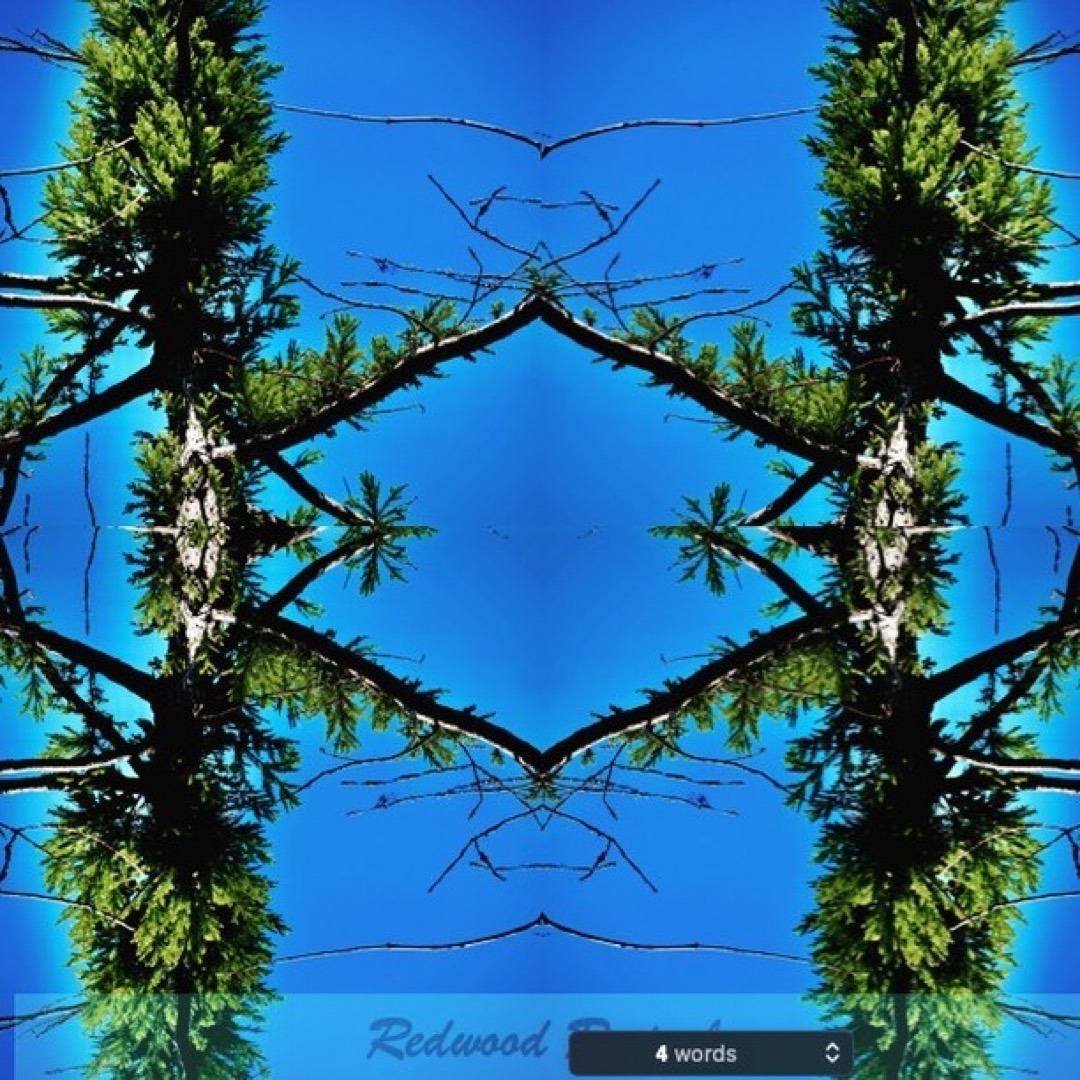
Deborah Kennedy
DANCING REDWOOD TREES
Digital photograph
These dancing redwood trees were created from a photograph I took of trees that had burned one year prior in the CZU wildfire. This fire consumed 86,500 acres and 911 homes in the Santa Cruz mountains. After one year, these redwood trees had sprouted bright-green, bushy growth directly from their blackened trunks. Further up in the mountains, the hills that had been covered with pale grey ash and bristling with thin black tree trunks were now dotted with new, dark green bushes. Nature is resilent. If we give it half a chance it will come blasting back. If we don’t, as they say: people are preceeded by forests and followed by deserts.
© 2022 Deborah Kennedy
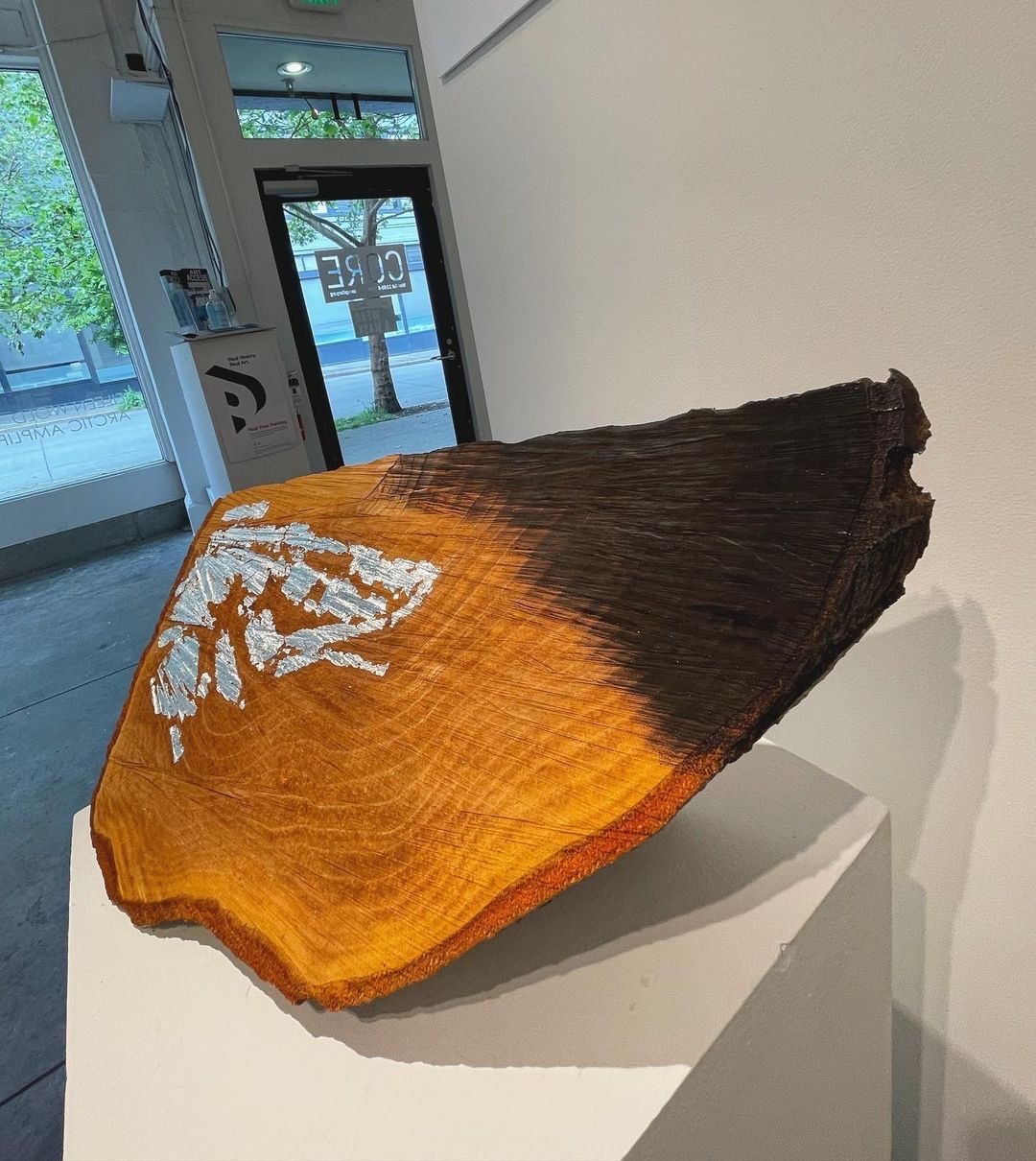
Eileen Wold
A SLICE OF RED ALDER WOOD
Red Alder wood
Silver leaf, burn
This slice of Red Alder wood has been silver leafed and burned to reference the connections we are finding between increased ice melt in the Arctic with increased intensity of wildfires in the Pacific Northwest region. How will we use this understanding of a deeper connection in the natural systems around us to protect lives, ecology, and culture?
Resilience boils down to an ability to adapt to both short-term disruption and long-term change while retaining the system’s essential identity. Building resilience starts with decisions about what we value about a system. Concepts like the adaptive cycle and panarchy further aid our understanding of resilience in systems.”
– Richard Heinberg
© Eileen Wold 2022
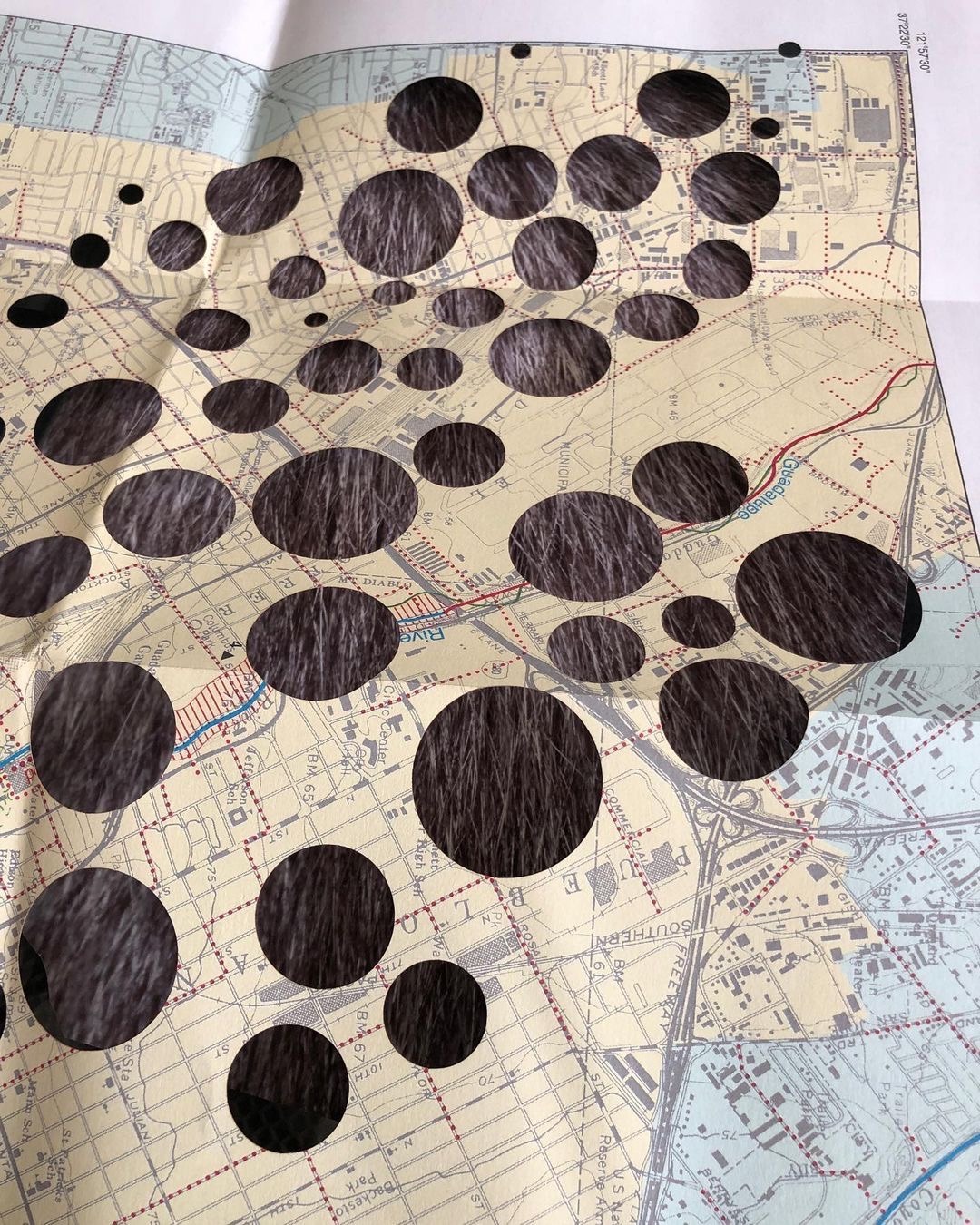
Lorem ipsum dolor sit amet, consectetur adipiscing elit. Ut elit tellus, luctus nec ullamcorper mattis, pulvinar dapibus leo.
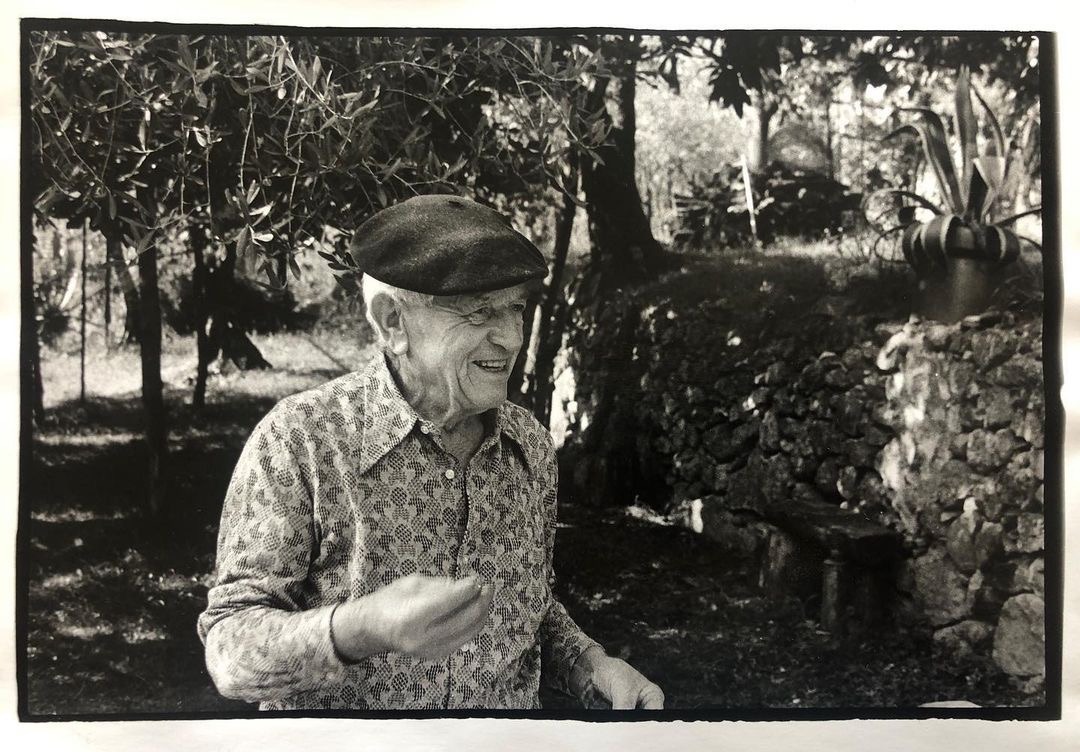
Lorem ipsum dolor sit amet, consectetur adipiscing elit. Ut elit tellus, luctus nec ullamcorper mattis, pulvinar dapibus leo.
About the Think Resilience Course
Lesson 1: Introduction
PART ONE
Chapter One – Our Converging Crisis
– Lesson 2: Energy
– Lesson 3: Population and Consumption
– Lesson 4: Depletion (Resources depletion)
– Lesson 5: Pollution
Chapter two – The Roots and Results of Our Crises
We explore the role of human behavior in our sustainability crises, and dig deeper into where those crises are taking us:
– Lesson 6- Political & Economic Management (Social Structure)
– Lesson 7- Belief Systems
– Lesson 8 – Biodiversity
– Lesson 9 – Collapse
Chapter three – Making Change
– Lesson 10 – Thinking in Systems
– Lesson 11 – Shifting Cultural Stories
– Lesson 12 – Culture Change and Neuroscience
– Lesson 13 – Think Resilience
Each video is approximately 12 minutes long.
Think Resilience is hosted by Richard Heinberg, one of the world’s leading experts on the urgency and challenges of moving society away from fossil fuels.
We live in a time of tremendous political, environmental, and economic upheaval. What should we do? Think Resilience is an online course offered by Post Carbon Institute to help you get started on doing something. It features twenty-two video lectures—about four hours total—by Richard Heinberg, one of the world’s foremost experts on the urgency and challenges of transitioning society away from fossil fuels. Think Resilience is rooted in Post Carbon Institute’s years of work in energy literacy and community resilience. It packs a lot of information into four hours, and by the end of the course you’ll have a good start on two important skills:
1. How to make sense of the complex challenges society now faces. What are the underlying, systemic forces at play? What brought us to this place? Acting without this understanding is like putting a bandage on a life-threatening injury.
2. How to build community resilience. While we must also act in our individual lives and as national and global citizens, building the resilience of our communities is an essential response to the 21st century’s multiple sustainability crises
What’s Next For Earth is an art project created in March 2020 by Michele Guieu, eco-artist, and MAHB Art Editor, to understand the human predicament and reflect on the climate emergency to take action. The project is supported by the MAHB and the Post Carbon Institute. If you have any questions, please send your message to michele@mahbonline.org.
Thank you ~

